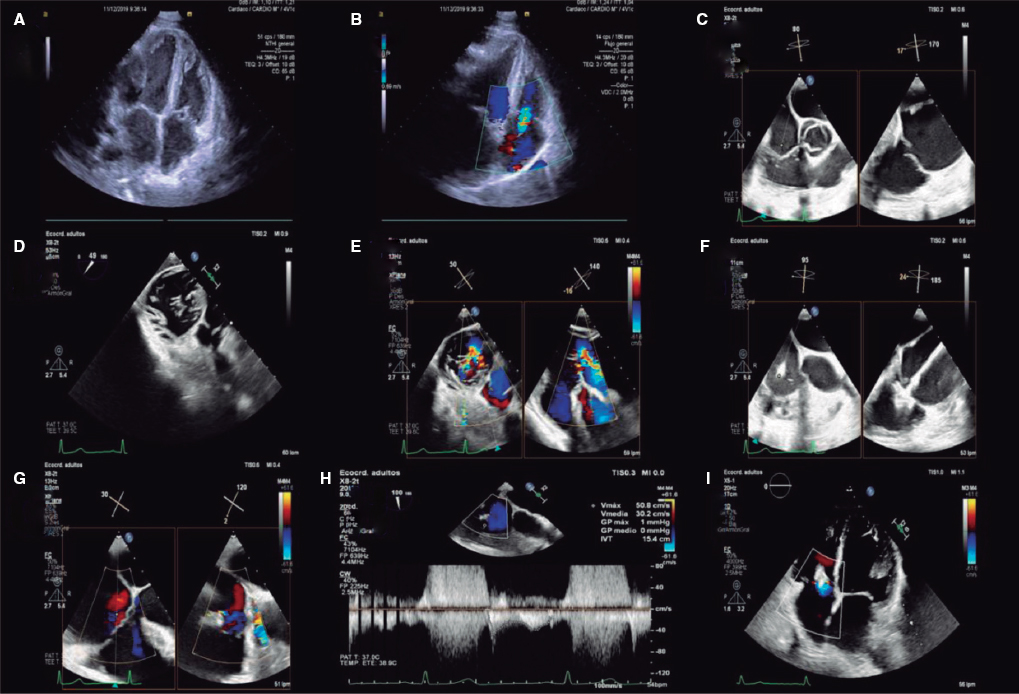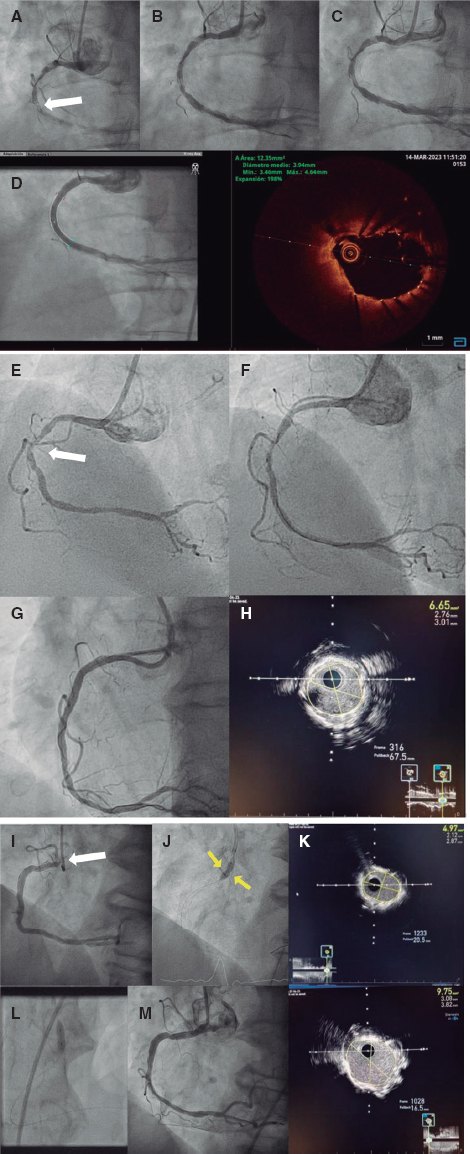QUESTION: In your opinion, what conclusions can be drawn from the 2 ORBITA trials?1,2
ANSWER: The 2 ORBITA studies aim to settle the debate on the utility of coronary revascularization in patients with stable chronic angina and coronary artery lesions causing ischemia in that territory. The first ORBITA trial1—a double-blind, multicenter clinical trial published in 2018—randomized 230 patients with stable angina and at least 1 severe coronary stenosis (> 70%) to undergo percutaneous coronary intervention (PCI) or receive placebo to assess the symptom relief of angina. After being included in the study, both groups received a strategy of medical therapy optimization 6 weeks prior to randomization. There were no significant differences at the 6-month follow-up in the primary endpoint of exercise tolerance between the 2 groups. The authors concluded that the efficacy of invasive procedures should be determined with placebo control only (without pharmacological optimization). This is precisely what the recently published ORBITA-2 trial2 aimed to address. This trial randomized 301 patients in 14 centers in the United Kingdom to receive PCI or placebo. Two weeks before randomization, all antianginal drugs were discontinued. All patients were required to have significant coronary artery disease and evidence of ischemia in at least 1 vascular territory. Both groups received dual antiplatelet therapy (including the placebo group). The primary endpoint (assessment of angina, need for medication, and events after the 12-week follow-up) favored the PCI group vs the placebo group, with improvements in the follow-up ergometry and quality of life tests. The authors conclude that, in patients with stable angina, coronary artery disease, evidence of ischemia in that vascular territory, and not on antianginal drugs, PCI was more effective in reducing angina symptoms than placebo.
In my opinion, both studies confirm 2 issues: on the one hand, that the first-line therapy in patients with stable angina is optimal medical therapy; on the other hand, that PCI improves the symptoms, exercise capacity, and quality of life of patients who continue to experience angina or treatment-related adverse effects.
Q.: What would be the key features aspects of these 2 studies?
A.: Methodologically, the 2 studies have been conducted appropriately, but with very few patients. In the ORBITA trial1, recruitment was not easy (230 patients in 4 years, in 5 major centers in the United Kingdom), meaning there is a patient selection bias (generally less severe patients). Coronary artery disease was estimated visually (lesions > 70%), without the use of intracoronary imaging, and not all lesions were proximal, which likely have a higher ischemic burden. Finally, 85% of patients who did not undergo PCI, were eventually treated with percutaneous coronary revascularization during follow-up.
The ORBITA-2 trial2 addressed some of these limitations by using intravascular imaging and coronary physiology, which identify really significant lesions and avoid treating lesions that are functionally nonsevere, reducing events during follow-up.3-5 However, once again, and in 14 centers, enrolling 300 patients took more than 4 years. Ethical aspects of the study have been criticized, as comparison vs placebo and not vs optimal medical therapy left the placebo group without any treatment for angina and exposed them to unnecessary bleeding risks due to dual antiplatelet therapy. Nevertheless, conducting the study in this manner seems timely, since both the true utility of PCI and even the foundations of coronary physiology were questioned following the results of the ORBITA trial,1 suggesting that an increase in fractional flow reserve in an ischemic territory had no impact at all, which has been elucidated in the ORBITA-2 trial.2
Finally, perioperative myocardial infarction remains the weak point of coronary interventions in all clinical trials. The definition of “perioperative infarction” includes everything from Q-wave infarction related to loss of epicardial branch to mild troponin elevation (the threshold is 5 times higher than the upper limit, according to the current definition6) due to complications occurring during potentially treatable intervention with good final outcomes (branch dissection, no-reflow, compromised temporary flow, etc). Undoubtedly, this limits revascularization options (whether percutaneous or surgical) in all clinical trials. Therefore, it would be advisable to differentiate between the type of infarction, particularly those with the most prognostic implications.
Q.: What do you think these 2 studies contribute compared with the much larger ISCHEMIA trial?
A.: The ISCHEMIA trial,7 published in 2020, was much larger, with more than 5000 patients with stable coronary artery disease and moderate-to-severe ischemia, randomized to an initial invasive strategy with coronary angiography and revascularization, when necessary, along with medical therapy, or to an initially conservative strategy, with medical therapy alone and angiography if insufficient. The aim of the study was prognostic—not symptomatic—assessment, with a composite endpoint of cardiovascular death, myocardial infarction, or hospitalization for unstable angina, heart failure, or resuscitated cardiac arrest. After a median follow-up of 3.2 years, the initial invasive strategy did not reduce the risk of cardiovascular ischemic events or all-cause mortality compared with the conservative strategy.
Setting aside the limitations and potential criticisms of the ISCHEMIA trial,7 such as recruitment difficulties, very rigorous inclusion criteria, the absence of severe ischemia in a high percentage of cases, and that 25% of patients in the conservative treatment group eventually underwent revascularization, it is obvious that the aim of the study is very different from that of the ORBITA and ORBITA-2 trials.
In general, the prognosis of chronic coronary syndromes is good, but it is difficult to demonstrate prognostic differences in this subgroup of patients after a mean follow-up of just over 3 years. Furthermore, the ISCHEMIA trial included a group of patients who were heterogeneous in certain aspects features excluded those with more severe coronary artery disease (such as left main coronary artery disease) or ventricular dysfunction, in whom the prognostic impact of revascularization is known to be greater.
Another issue is symptom relief and quality of life. Indeed, the authors of the ISCHEMIA trial7 reported clinical implications and improvements in terms of quality of life. Although 35% of patients remained asymptomatic, the invasive strategy was associated with an improvement in angina-related quality of life, especially in patients with complete revascularization.8 This difference was greater for symptomatic patients.
The ORBITA trials focus on symptom relief in patients with chronic coronary syndromes, but with significantly fewer patients and shorter follow-up periods to demonstrate improvement in exercise capacity and quality of life, which were indeed observed in the secondary endpoints of the ISCHEMIA trial.
Q.: Based on all this evidence, what are the benefits, if any, of the invasive strategy over the conservative approach?
A.: The advantage of the invasive strategy over the conservative approach as first-line therapy has not been demonstrated in patients with chronic coronary syndromes. The cornerstone of therapy for patients with chronic angina is optimal medical therapy, as stated by clinical practice guidelines. In fact, the publication of the ORBITA trials has not changed these guidelines at all.
However, considering the results of these studies, we can be in no doubt that PCI is the best therapeutic option in patients who cannot control their symptoms with drugs, with drug-related adverse effects, or even those who simply do not want to continue taking drugs to control their symptoms. Revascularizing these patients is possible with good results and symptom relief.
We will have to wait for longer-term follow-up of the ISCHEMIA trial7 to evaluate whether coronary revascularization in patients with stable chronic angina has any prognostic impact. For the time being, until further evidence becomes available for confirmation, we know that the patients included in the study treated with complete revascularization experienced fewer events (cardiovascular death or myocardial infarction) during follow-up than those undergoing incomplete revascularization or an initial conservative strategy.9 Additionally, myocardial infarctions during follow-up (separating them from the perioperative infarctions with the above-mentioned implications) were also fewer in the group who initially underwent the invasive strategy.10
Finally, we should consider that all 3 studies included patients with generally low-risk chronic coronary syndromes, most with clearly demonstrated moderate ischemia, and single-vessel involvement, so their results are not generalizable to patients with more complex coronary artery disease, such as multivessel disease, left main coronary artery disease, or associated ventricular dysfunction.11 Therefore, the correct identification and characterization of coronary artery disease are important, which almost always requires noninvasive coronary angiography, or invasive angiography if the former is inconclusive. Another question arises: once coronary artery disease has been accurately assessed, should the patient undergo revascularization or should a conservative approach to their lesions be pursued for symptom relief? Or, depending on the extent or severity of the coronary artery disease and the myocardial territory at risk, is a more aggressive approach necessary, with either percutaneous or surgical revascularization?
Q.: What indications do you take into consideration in your routine clinical practice to decide which invasive approach to use in a patient with stable angina?
A.: The results obtained in the ORBITA trials maintain medical therapy as the first option for patients with chronic angina and relegate the invasive approach to those with symptoms that cannot be resolved despite optimal medical therapy. This would, therefore, be the indication in stable chronic angina. However, such results cannot be extrapolated to patients with multivessel disease and severe ischemia, so it would be a mistake to take them as a reference to stop performing coronary angiograms, which would imply avoiding the revascularization of patients at higher risk than indicated by their symptoms. Therefore, as always in medicine, each patient should be individually evaluated to determine who requires an earlier invasive approach based on their symptoms and multiple other factors. We’ll still have to wait for longer-term results, even for these lower-risk patients due to their lower ischemic burden, to see how the story ends.
FUNDING
None declared.
STATEMENT ON THE USE OF ARTIFICIAL INTELLIGENCE
No artificial intelligence was used in the preparation of this article.
CONFLICTS OF INTEREST
None declared.
REFERENCES
1. Al-Lamee R, Thompson D, Dehbi H-M, et al. Percutaneous coronary intervention in stable angina (ORBITA):a double-blind, randomised controlled trial. Lancet. 2018;391:31-40.
2. Rajkumar CA, Foley MJ, Ahmed-Jushuf F, et al. A Placebo-Controlled Trial of Percutaneous Coronary Intervention for Stable Angina. N Engl J Med. 2023;389:2319-2330.
3. Holm NR, Andreasen LN, Neghabat O, et al. OCTOBER Trial Group. OCT or Angiography Guidance for PCI in Complex Bifurcation Lesions. N Engl J Med. 2023;389:1477-1487.
4. Lee JM, Choi KH, Song YB, et al. RENOVATE-COMPLEX-PCI Investigators. Intravascular Imaging-Guided or Angiography-Guided Complex PCI. N Engl J Med. 2023;388:1668-1679.
5. Tonino PAL, De Bruyne B, Pijls NHJ, et al. FAME Study Investigators. Fractional flow reserve versus angiography for guiding percutaneous coronary intervention. N Engl J Med. 2009;360:213-224.
6. Thygesen K, Alpert JS, Jaffe AS, et al. Executive Group on behalf of the Joint European Society of Cardiology (ESC)/American College of Cardiology (ACC)/American Heart Association (AHA)/World Heart Federation (WHF) Task Force for the Universal Definition of Myocardial Infarction. Fourth Universal Definition of Myocardial Infarction (2018). J Am Coll Cardiol. 2018;72:2231-2264.
7. Maron DJ, Hochman JS, Reynolds HR, et al. ISCHEMIA Research Group. Initial Invasive or Conservative Strategy for Stable Coronary Disease. N Engl J Med. 2020;382:1395-1407.
8. Mavromatis K, Jones PG, Ali ZA, et al. ISCHEMIA Research Group. Complete Revascularization and Angina-Related Health Status in the ISCHEMIA Trial. J Am Coll Cardiol. 2023;82:295-313.
9. Stone GW, Ali ZA, O'Brien SM, et al.;ISCHEMIA Research Group. Impact of Complete Revascularization in the ISCHEMIA Trial. J Am Coll Cardiol. 2023;82:1175-1188.
10. Redfors B, Stone GW, Alexander JH, et al. Outcomes According to Coronary Revascularization Modality in the ISCHEMIA Trial. J Am Coll Cardiol. 2024;83:549-558.
11. Al-Mallah MH, Ahmed AI, Nabi F, et al. Outcomes of patients with moderate-to-severe ischemia excluded from the ISCHEMIA trial. J Nucl Cardiol. 2022;29:1100-1105.














